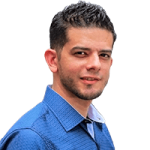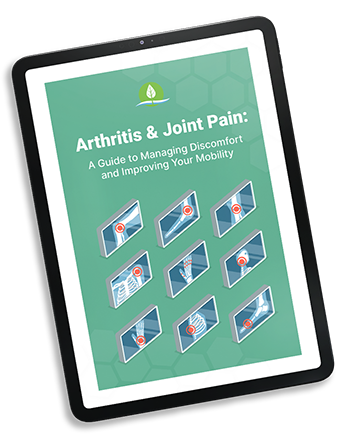Do you have joint pain?
You’re not alone.
Millions of people suffer from joint pain and stiffness, and while many turn to prescription or over-the-counter medications, these often have unwanted side effects.
Fortunately, in many patients, foods can help with long-term joint pain relief.
In this article, we will explore the foods that can help to ease joint pain, as well as which foods you should avoid.

What is joint pain?
Joint pain is an extremely common complaint that can cause significant distress and disability.
It can be caused by various conditions, including rheumatoid arthritis, heart disease, and autoimmune problems.
Joint pain can range from mild to severe and can occur in any joint in the body. It is usually accompanied by stiffness, swelling, redness, and loss of range of motion.
Joint pain can be an early sign of arthritis, a group of conditions that cause joint inflammation.
Osteoarthritis, rheumatoid arthritis, gout, and other forms of arthritis can all cause joint pain.
Traumatic injuries such as fractures, dislocations, and sprains can also cause joint pain. Overuse of a particular joint or joint groups, such as in athletes or those with occupations that put stress on the joints, can lead to joint pain as well.
Treatment for joint pain varies depending on the underlying cause and severity of the symptoms.
Pain relief medications such as non-steroidal anti-inflammatory drugs (NSAIDs) and corticosteroids can be effective for short-term relief.
Other treatments, such as physical therapy, massage, and lifestyle changes, can help reduce and manage joint pain in the long term. That’s why it is essential to review the list of foods that cause and help relieve joint pain.
Foods that help joint pain
Joint pain can be a debilitating symptom that can significantly impact the quality of life. Fortunately, certain foods can be used for this type of pain. They provide nutrients that may reduce joint pain symptoms:
Omega 3
Omega-3 fatty acids have natural anti-inflammatory properties and are among the best foods for arthritis and joint pain, including fish, nuts, and flaxseeds.
Vitamin C foods
Vitamin C, present in citrus fruits, helps to form new collagen. This can help to rebuild and strengthen joints.
Vitamin D foods
Vitamin D, found in eggs and fatty fish, helps the body absorb calcium, and some studies suggest that it may reduce joint pain symptoms.
Phytonutrients
Phytonutrients in some herbs, such as turmeric, are known to have anti-inflammatory properties that can help reduce joint pain.
Foods for arthritis
If you’re looking for good food for arthritis that helps relieve joint pain, take a look at these foods to eat:
Nuts
Are peanuts, pistachios, and almonds anti-inflammatory? Nuts, like almonds and peanuts, contain healthy fats with anti-inflammatory effects.
Besides being foods to reduce inflammation in the joints, they also decrease the blood level of bad cholesterol.
Vegetables
Cruciferous vegetables and members of the brassica family, for example, cauliflower and broccoli. They relieve arthritis pain flares and lower systemic inflammation.
Green leafy vegetables, which have the antioxidant compound kaempferol, are known to alleviate interleukin-induced inflammation.
Kale is one of the best leafy greens you can consume because it also has sulforaphane, which has potent anti-arthritis effects.
Root vegetables, such as garlic and potatoes, are excellent foods for knee pain and arthritis.
Garlic gives you antioxidant and anti-inflammatory phytonutrients, and potatoes give you healthy carbohydrates. That’s why root veggies are recommended.
Bone broth
Bone broth (natural preparation, not processed) contains glucosamine and can benefit patients with osteoporosis.
Fish oil
Fish oil consumption is also beneficial, either in a fish oil supplement or eating fatty fish like salmon, which is the best food for your joints.
Pineapples
Pineapple is the best fruit for arthritis due to its bromelain content. However, most bromelain is contained in the pineapple core, and you should eat it, too.
Olive oil
Olive oil is often used for salad dressings in the arthritis community as it improves joint pain and brain function.
Ginger
Ginger, which you can consume in powder or extract to add a spicy nutrient mix to your meals.
Berries
Berries, especially strawberries, blackberries, and blueberries, are one of the best foods you can consume for your joints. They contain anthocyanins with a potent antioxidant effect.
Green tea
Green tea is the best substitute for fizzy drinks and sugary juices if you’re looking for foods and beverages for sore muscles and joints.
Knee pain, arthritis, gout, and other types of joint pain can be relieved with these foods. As you can probably see, the best food for pain relief in an arthritis patient should come from natural sources and contain antioxidant and anti-inflammatory substances.

Foods that cause joint pain
After reviewing the best foods for joint pain, we should also mention some foods that may have adverse effects and trigger or worsen joint pain.
For example, saturated fats and excess sodium, as found in some processed foods, may increase inflammation, which makes joint pain worse.
Therefore, it is important to maintain a balanced diet that incorporates foods that help reduce joint pain while avoiding foods that worsen it.
Many foods can contribute to this symptom. Many of these foods are high in saturated fats, processed sugars, and artificial ingredients and should be out of your joint pain diet.
The usual mechanism of action is through inflammation, which causes and worsens many conditions.
These are examples of foods that cause joint pain:
Processed meat
Processed meats, such as hot dogs and bacon, are notorious for being high in saturated fats and can lead to joint pain if consumed too often.
Dairy
Dairy products, like butter and cheese, are high in saturated fats. Thus, it is better to resort to skimmed milk or dairy-free milk.
High-sodium foods
Foods high in sodium can make your joints swell and increase stiffness. High levels of sodium can also cause water retention, which worsens joint pain.
Foods such as canned soups, salted nuts, and processed foods are all culprits here.
Refined sugar
Refined sugars and foods with high sugar content create an acidic environment in your body that can contribute to inflammation. That’s why sugary foods are not recommended.
Trans fats
Lastly, foods high in trans fats should be avoided because they are highly inflammatory. Trans fats are typically found in processed foods, such as store-bought baked goods, fried foods, and margarine.
Some foods are in the grey zone and can have adverse effects in some but not other patients.
For example, nightshade vegetables, which can worsen pain in some patients with gout. Whole grains are also in this category because some research shows that they can trigger inflammation despite their health benefits, especially in patients with celiac disease.
Avoiding these foods and making healthier choices can reduce your risk of joint pain and other inflammatory issues.
Eating a balanced diet with plenty of fruits and vegetables can help keep your joints healthy and maintain pain-free movement.
How do I reduce inflammation in my joints?
Inflammation of the joints can be painful and irritating and can limit your mobility and quality of life. That’s why reducing joint inflammation is so important, and there are a few key ways to do that.
One of the best ways to reduce joint inflammation is through diet and nutrition. Eating a balanced diet that is low in processed foods and high in fiber, omega-3 fatty acids, and antioxidant-rich foods can help reduce joint inflammation.
Supplements such as glucosamine and chondroitin can also help reduce joint inflammation.
Exercise and stretching are also important components of reducing joint inflammation. Regular exercise can help maintain joint flexibility and strength, while stretching can help improve the range of motion in the affected joint.
It is important to consult with a physician to ensure the exercises are done properly and safely.
Additionally, hot and cold therapies can be used to control joint inflammation. Applying heat to the affected joint can help increase blood flow and reduce morning stiffness and pain. Cold therapy can relieve pain by reducing swelling and inflammation.
Get Your FREE Arthritis Guide
- Learn how to naturally improve your arthritis symptoms
- Dietary recommendations, exercise guides, supplements, and lifestyle changes
- Developed exclusively by our medical doctor
Tips to relieve joint pain
To help you manage joint pain, here are some tips to consider:
- Adopt a Mediterranean diet, which is considered anti-inflammatory and includes recommendations similar to the above.
- Exercising regularly can help reduce joint pain and improve mobility. Gentle stretching exercises and low-impact activities such as swimming, yoga, and walking can help increase flexibility, strengthen muscle support, and lubricate the joint.
- Increasing muscle strength helps to reduce the load on the joint and can decrease pain. It is important to listen to your body and not overdo it.
- Losing weight can help ease joint pain. Excess body weight puts extra strain on the joints, especially the hips, knees, and ankles. Losing even a few pounds can reduce the pressure on the joints and relieve symptoms.
- Using assistive devices can support the joints and reduce pain. A cane, walker, or another device can help take some of the load off joints and help you move with less pain.
- A heating pad or ice pack can provide temporary relief.
- Nonsteroidal anti-inflammatory drugs (NSAIDs) can help with inflammation and reduce joint pain. It is essential to talk to your doctor before taking any medication to make sure it is safe and to ensure proper dosage.
Ben’s Joint Care Pro
Joint Care Pro, our joint health supplement, contains natural, proven ingredients that support joint care and joint health.

It is designed to improve mobility and flexibility, reduce joint pain, restore joint strength, protect cartilage and joint tissue, and rebuild strength and density.
Conclusion
Joint pain is a common physical discomfort that can affect people of all ages, typically caused by inflammation.
It is often associated with chronic conditions such as arthritis and gout, as well as more short-term injuries. While medications can reduce pain and inflammation, a proper diet can also be beneficial.
So, what foods help with joint pain? Natural arthritis treatment is complemented with food rich in omega-3 fatty acids and ingredients such as ginger, turmeric, and green leafy vegetables.
Additionally, sugary and processed foods can promote inflammation, so avoiding these foods is recommended to manage joint pain. Eating a balanced diet, along with moderate exercise, can help to reduce pain and improve joint health.
Explore More







